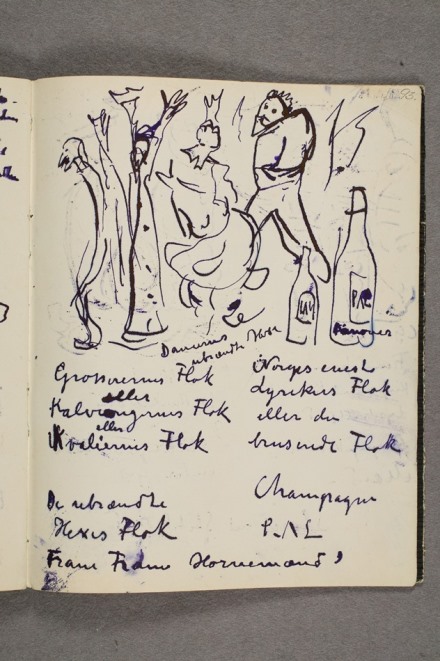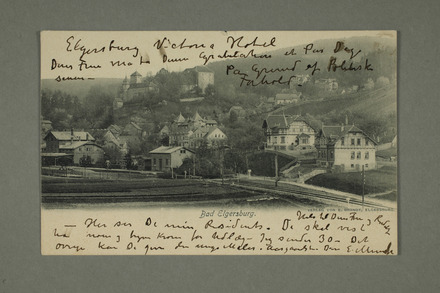Building an Edvard Munch website
Hilde Bøe
Introduction. Edvard Munch’s texts
In this paper I will present the project Edvard Munch’s texts and give an outline of some of our plans for the eMunch website.
The Munch Museum recently initiated a three-year project that will result in a website where all manuscripts after the Norwegian artist Edvard Munch (1863–1944) will be published. The collection belonging to the museum consists of a major part of Munch’s complete artistic oeuvre as well as a near complete collection of his letters, journals and notes. The textual material consists of more than 13 000 pages. A complete, critical and commented publication of the manuscript material has been in great demand among Munch scholars for a long time, both internationally and in Norway.
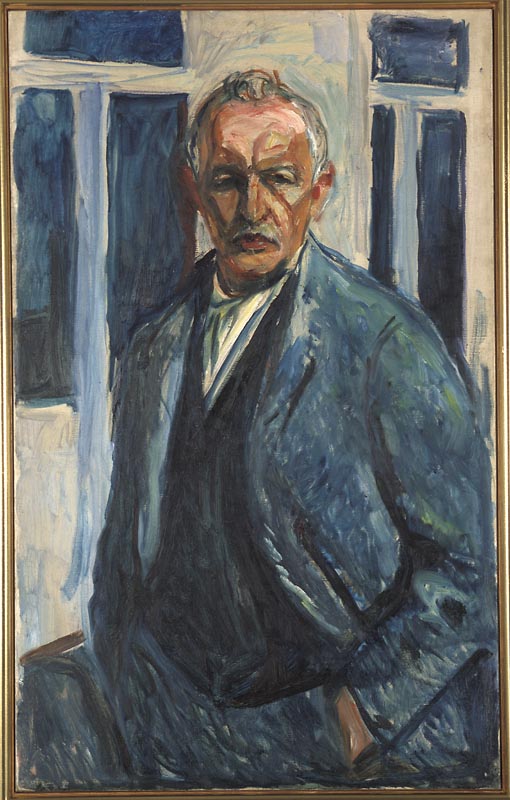
M 753. Self-portrait
Up until today the interested reader of Munch has had to visit the museum’s library and commit herself to plain old-fashioned reading without any of the modern facilities we’ve learnt to expect; e.g. a complete digital register of the texts or digital facsimiles for closer looks at the manuscripts. Parts of the material are available in non-digitalised transcripts at the library, and researchers can view the originals on request, while others only in exceptional cases and under supervision of the librarians are allowed access to the originals. And then she needs to know what she wants to look at, and unfortunately not all of the material has been registered. This restricted and cumbersome situation stems partly from the fact that the museum was established in 1963, only 19 years after Munch’s death. Because many of the texts are of a very private character it was necessary to be discreet and careful when managing the collection. In more recent years the situation also stems from the lack of economic resources, which has made it difficult to develop the desired facilities. Taken together this has led to limited publishing and a tendency in the research to re-use the texts that have already been published. Knowing how inaccessible the texts have been, it’s not surprising that there has been little research in Munch’s writings.
Special types of text. Object presentation in eMunch
The 13 000 pages of manuscripts are a composite material, containing several types of text:
- Literary journals
- Letters; include conventional letters, telegrams, postcards with or without illustrations
- Drafts for letters
- Newspaper and magazine articles
- Articles in exhibition catalogues
- Exhibition lists
- Shopping lists
- Munch’s private accounts and drafts for income tax forms
- And from his days in elementary school essays, dictations, exercises in handwriting, and so on
The main types are literary journals, letters and drafts for letters. Some of these types elude the otherwise often straightforward process of transcribing, encoding and representing, e.g. these:
- Sketchbooks and journals. Containing sketches, but also an occasional text, possibly but not necessarily connected to a sketch. Texts are scattered across the pages as well as throughout the book, and they can be written in different directions and in-between sketches; all of this contribute, along with the fragmentary structure of the content of the book itself, to complicating the process of transcribing, encoding and representing
- Printed forms. E.g. income tax forms with small amounts of handwritten text scattered across the pages, or telegrams where text is filled in in the appropriate fields. The complicating factor for transcribing, encoding and representing is the intricate structure of the forms and the fact that, although Munch’s text and the text of the form are interconnected, the text of the form is irrelevant to our end users because it’s not Munch’s, but without it Munch’s text loses its function
- Illustrated postcards. On some of his postcards Munch has written on the illustration, some times because there was too little space on the other side of the postcard, but more often because he wants to say something about the motif, e.g. to explain where his hotel is
There are quite a few of these types of text in the arts and the humanities, and because we want to search, analyse and organise the texts it is still necessary to transcribe them. The problem lies in representation: Without its context, understanding such a text becomes difficult. The new module «Digital Facsimiles» in chapter 11 of the TEI Guidelines does however offer a custom-made encoding solution for these types of text. Using the Image Markup Tool (IMT), which uses the «Digital Facsimiles» module, for the encoding of the files and the building of web views changes the formerly nearly impossible task of creating diplomatic representations to radical opportunity. Previously we either had to leave the text incomprehensible because it lost its context, or we would make the encoder’s task almost insurmountable asking her to represent the structure of e.g. an income tax form as diplomatically as possible. Now these types no longer pose problems: Representation in context and searching are surprisingly easy to achieve.
We encode Munch’s texts using the IMT, and we then use xInclude to collect all images and XML pages from one textual object into a single object. In this way we can avoid the multiplied versions of style sheets and schemas, which the IMT creates for every single web view. We have combined the IMT XSLT and CSS style sheets with our own and use these to transform the collected object into a single representation on the website.
The eMunch archive will present the Munch material in a default view with the digital facsimile and the transcribed text side by side. We would like to term this a hybrid view. It includes image and text plus a floating menu with links to image, transcribed text and annotation categories. Annotations are presented as pop ups. The annotated areas in the image are enlarged when double-clicked. If the direction of the text in the area is e.g. vertical or upside down, the area is rotated simultaneously as it’s enlarged. Links to the next and/or the previous page(s) are available so the user is able to browse through all the pages of the manuscript. There will also be a link to the manuscript description and presentation.
In this way we believe we give our end users the opportunity to have the visual and the textual context always and immediately available while they’re reading the transcribed text, and at the same time we’re making it possible for them to read comments and notes and check details in the enlarged areas of the facsimile. Time previously lost switching between text and facsimile trying to find out where in the facsimile the text belongs and what the context is can now be used for better purposes.
Linking texts and artworks. Visualising relationships through timelines
It is hard to separate the literary from the private in Munch’s writings. Most of his written production – from literary journals to letters – is integrated in his rhetorical emphasis on an inseparable unity between life and art. Throughout this heterogeneous material he constantly refers to the same childhood memories, love stories, broken friendships and intrigues. But just as Munch’s works of art put into play the relationship between the private memory and the universal experience, the reader of his writings will find that the line between fiction and reality is also hard to establish here.
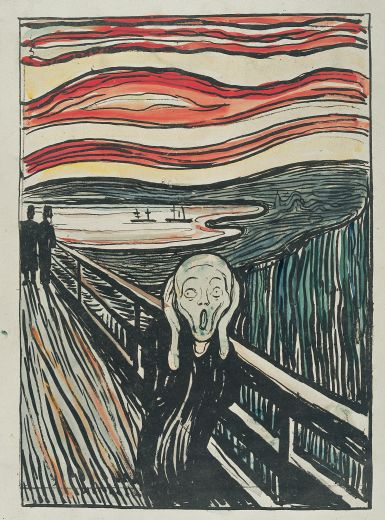
The Scream. Litograph
We aim therefore at connecting the artist and the writer and make his texts available for study alongside his artworks, and thereby we will hopefully broaden the understanding of Munch, his life and oeuvre.
A major challenge in this task is the existence of several versions (which often are created years apart) of both artworks and texts. Munch’s «The Scream» is a world famous icon and the painting and the lithograph (in its many versions, where some also includes text) is well known, but it is not commonly known that Munch also wrote several texts describing the situation that is depicted. There also exists a drawing with a text along its right side. The motif and text is clearly related to «The Scream», and it is generally regarded as an early version of «The Scream» although it is entitled «Despair».
How should we encode, annotate and present this web of connections and associations, how to connect the works of art and the texts to open them up for investigation instead of defining the connections and establishing our interpretations in the representation? Identifying texts and artworks as versions of the same is a task which will always imply a degree of interpretation, and a task where scholars therefore from time to time will conclude differently and disagree. By being explicit about how we decide what should belong together and by publishing our arguments in comments, we hope to make discussion with others possible.
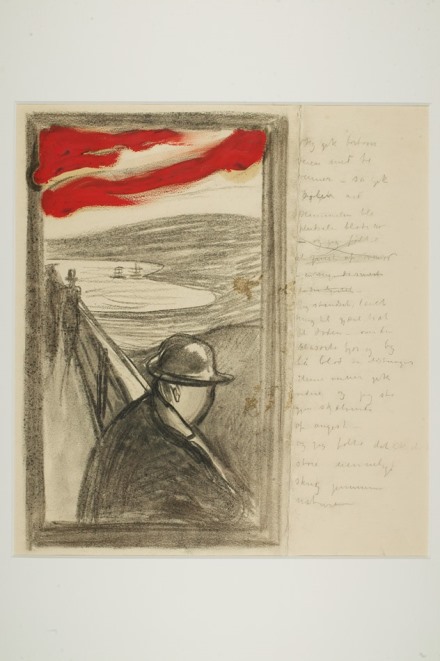
Despair. 1891–1892. Charcoal, oil paint, 370x422mm, MM T 2367
Linking together references of artworks in texts with a particular artwork can also be a difficult task because of Munch’s habit to create several versions of an artwork. We have decided to always include a comment in-between the text and the artwork, and then the comment will explain the connection: Is this in fact the actual referenced artwork? Is it an example because we know that the referenced work of art has disappeared? Maybe the reference is to a planned artwork that was never realised? Is more than one artwork possible? And so on. In this way we hope to avoid giving the impression of absolute identity between the text’s referenced artwork and one particular artwork. Perhaps at times we will need to include more than one artwork after the comment, and present the user with the most likely selection of artworks.
Another difficult task in a collection of manuscripts like this one is to identify broken physical relationships, i.e. objects currently separated into parts, but which used to belong together and ought to be linked to each other or brought back together in the text archive. In Munch’s case we have a couple of categories within this:
- Texts or sketches on pages torn or cut out of sketchbooks
- Parts of texts which for some reason now are separated from each other, causing a break in the content
We do not have the resources for a complete survey of the material, but we will try to mend all the broken relationships that we find working our way through the material. We will also use various methods to find missing parts, where we suspect that something’s lost. Connections between separate leaves and sketchbooks can be found comparing leaf measures and paper quality, while separated parts of a text can be located e.g. through collating larger versions of the same text against the texts in the archive, or through searching for key words in the text.
Dating Munch’s works of art and his texts is a difficult task, but it clearly is important. Building timelines and thus making it possible to illustrate the chronological relationship between texts and artworks is an important task in this project. We plan to establish this step by step during the project, building on the dates already present in parts of the material. We expect this to help us dating more of the texts. We are experimenting with timelines, and this one shows some of the postcards Munch sent. Visualising what we know about Munch and his life in this way, gives a more intuitive experience of the material.
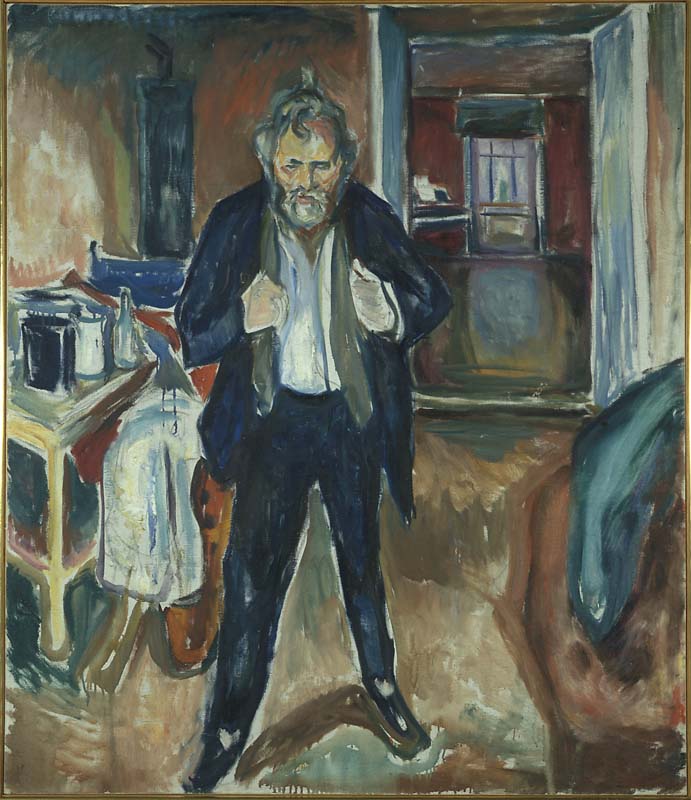
M 76. Self-portrait
Conclusion. Marking up text in images
To conclude: The challenge in building a website for Munch’s texts is dual. On the one side there is the technical issues connected to the encoding and presentation of a composite textual material. On the other side, there are the difficulties in deciding what belongs together. This problem is also dual, involving partly thematic relationships, as in the case of «Scream», and partly physical relationships, as with trying to identify where leaves torn out of sketchbooks used to belong.
With an artist like Edvard Munch, who worked in so many different genres and who left us such a diverse material, the largest challenges are not the technical ones, but the scholarly ones. Today we can decide rather easy on a technical solution for the website, but the scholarly work with the texts will go on and on because of the nature of the material. From this follow that we should arrange for a way to include future contributions to the scholarly content of the archive.
Finally I’d like to invite you to visit the project’s website where we will be publishing experimental material etc. – Thank you!


